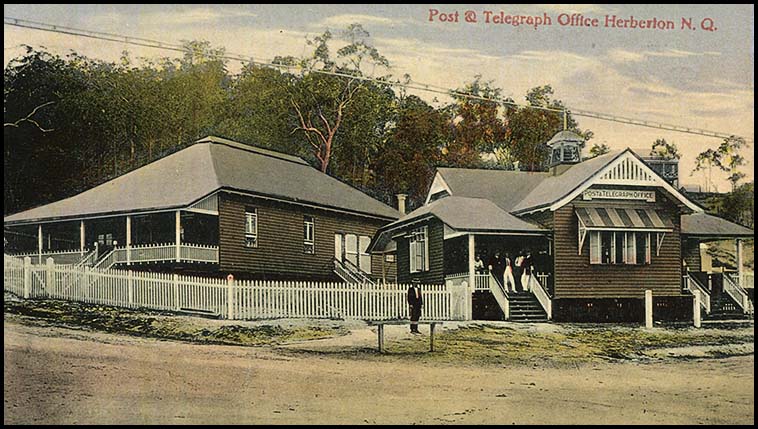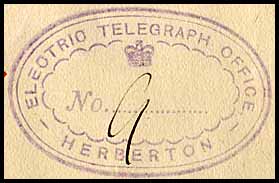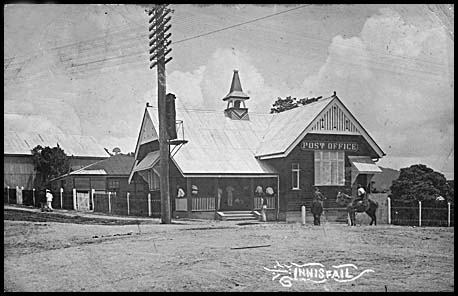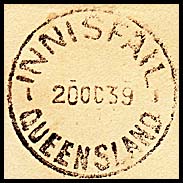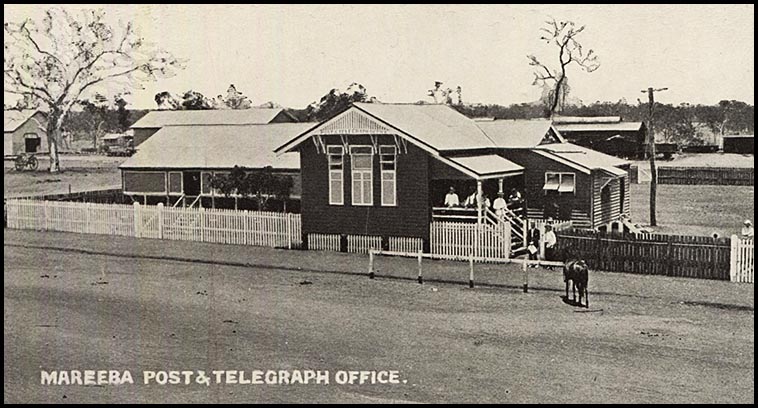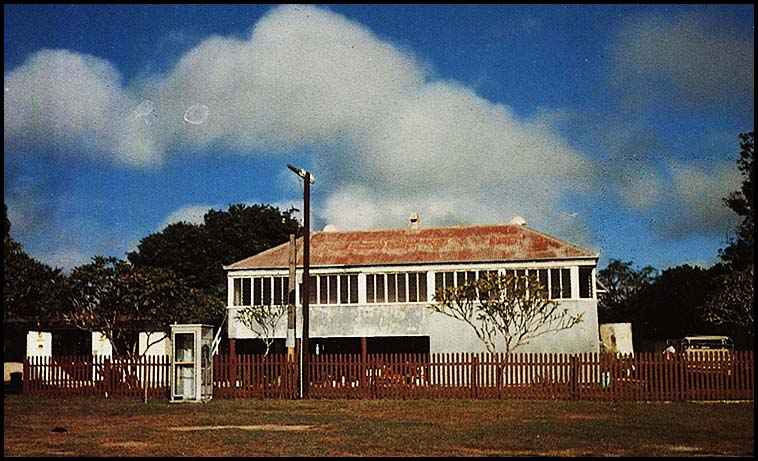Telegraph Offices on Cape York.
- Australia 1901-1988
- New South Wales
- Queensland
- South Australia
- Tasmania
- Victoria
- Western Australia
- International
- Special aspects
The following Telegraph Offices are included in this page:
| Cairns
The Telegraph Office was opened on 25 September 1878. On 3 October 1877, the Legislative Assembly had approved £2,500 for the construction of a Post & Telegraph Office. In 1880, 3,581 messages were sent including 442 OHMS messages. The telegraph staff consisted of an Electric Telegraph Station Master and a line repairer in charge. The Cairns Post of 31 January 1938 reported: "On Saturday morning (29th), a sale was conducted of the old telegraph building in Abbott Street adjoining the Cairns Post Office. It was conducted by Messrs. E. M. Boden and Co., the auctioneer being Mr. D. Dillon. The premises were disposed of for removal to Mr. D. R. Peiniger, 170 Lake Street, for £58. This will remove one of the oldest landmarks of Cairns". |
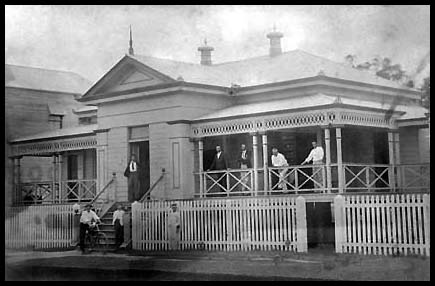 Cairns PO c. 1897. Source: NLA J2879 QTH447. |
 A new telegraph office was built at a cost of £7,500. It was situated in Spence Street facing Anzac Park. This "old Telegraph Office" in Spence Street was demolished in 2006 after approval by the Cairns City Council. |
|
Two date stamps were issued to Cairns for use with telegraphic business:
|
|
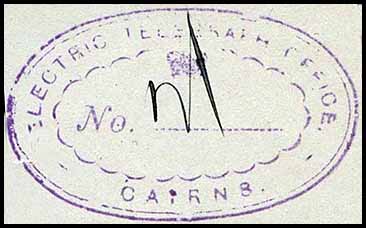 No date. Provenance: Dave Elsemore. |
|
|
|
Only one slogan postmark advertising Telegrams is recorded as being used at Cairns - SEND A TELEGRAM.
|
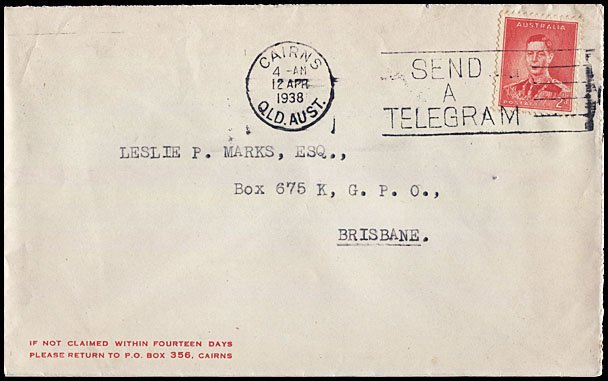 |
|
| Cape York.
The Telegraph Office replaced the Paterson Telegraph Office in 1894. It became a Post Office in 1910 and closed on 14 September 1960. In some Telegraph Offices where there is not a continuous demand, it is important for operators and others to develop an outside interest: On 17 July 1896, The Week reported "Some of the residents of Thursday Island have been greatly troubled for some time past (says the Croydon Mining News) concerning the location of "The Dead Man's Secret" - believed by them to be a phenomenally rich reef in some part of Cape York Peninsula. Mr. T. Tracey, of the Australian Hotel, Golden Gate, knows where the reef is situated and leaves by the outgoing steamer for Thursday Island, whence he will take a party to Cape York and show them the much desired lode. This was discovered some years ago by an operator named Neal, who was in charge of the Telegraph Office at Cape York. The reef is big but it remains to be seen whether it will pay to work it". |
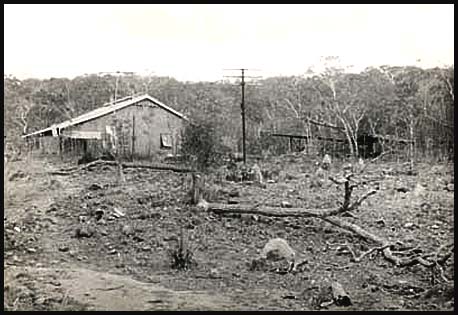 Cape York repeater station in 1949. Source: National Archives of Australia J3088. |
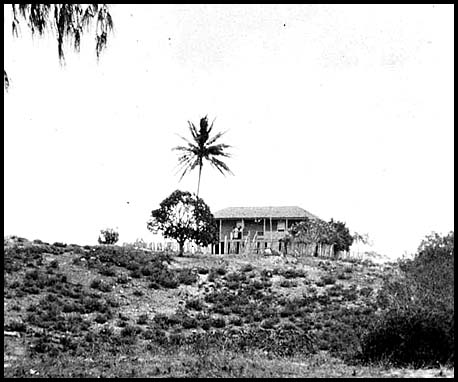 Cape York Post Office about 1935. |
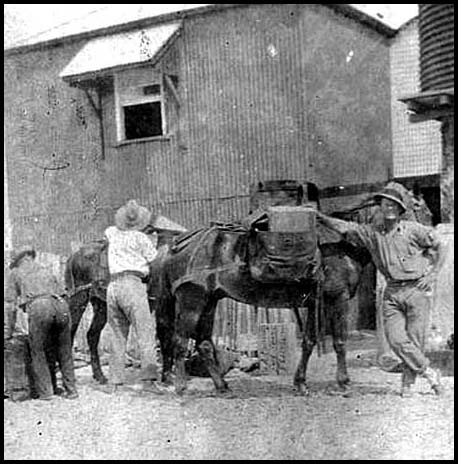 Cape York - Unloading horses at the P&T 1905. |
|
 18 July 1908 - during the Receiving Office period. Pays rate for a telegram of 16 words sent interstate. Abacus Auctions October 2021 Lot 535. |
|
A telegraph Office was opened at Coen in 1886 using the same prefabricated design as was used for the Musgrave Telegraph Office. See also the description elsewhere. During 1941, a new airfield was built about 20 miles north of Coen to help in Australia's defensive strategy. Unfortunately the Coen Telegraph Station still only had morse code facilities and a local telephone exchange switchboard. |
|
The usual postal date stamp was used at Coen.
|
 9 July 1904. See cover for Moreton below. |
|
In August 1874, a one acre block was reserved in Cooktown for the construction of a Telegraph office. This block was purchased by the Government for £120 soon after. "It is much required, the present office having no dwelling attached for the accommodation of the Telegraph Master". The telegraph office was opened at Cooktown in June 1876. The Week of 6 April 1878 reported: "A daring attempt at burglary was made at the Cooktown telegraph office early this morning. Mrs. Cowl heard a noise and woke her husband, who forthwith instituted a search, which resulted in his discovering a Chinaman in the instrument room. The Celestial escaped through the window and another, who was with him, made a bolt through the bedroom. Mrs. Cowl attempted to stop him but received a heavy blow, from what is supposed to be an iron implement, inflicting a severe bruise on the thigh. The Celestials escaped. The lodgers at the Sovereign Hotel, hearing Mrs. Cowl's screams, rushed over but the burglars were gone". |
|
No special date stamp for telegraph use was issued to Cooktown. The usual postal date stamps were used instead. An unframed Cooktown date stamp used in the early Federation period. |
 24 July 1903. On 1s violet Queen - possibly paying the interstate rate for a 16 word telegram. |
In 1880, 15,327 messages were sent including 1,202 OHMS messages. The telegraph staff consisted of an Electric Telegraph Station Master, 1 operator, 1 line repairer, 1 clerical assistant and 2 messengers. Cooktown Coastal Radio: It was reported on 27 September 1912 that Senator Findley, in reply to Senator Sayers (Q ), said that a site had been selected for a wireless telegraph station at Cooktown, and the equipment ordered for this station would be opened in April. The Station was finally opened on 12 June 1913. |
|
|
A telegraph Office was opened in Fairview about 1884 using the same prefabricated design as was used for the Musgrave Telegraph Office. A Receiving Office was opened on 1 July 1895 which was converted to a Post Office in February 1902. This changed back to a Receiving Office in March 1905 and then reverted to a Post Office from 1 July 1927 to 31 March 1934. |
|
| Herberton.
The Telegraph Office opened on 6 April 1887. A description of the silver mine was published on 25 December 1886. |
| Two formats for oval date stamps were issued to the Herberton Post and Telegraph Office for use with telegraphs. Both were oval Electric Telegraph Office formats:
BO7 - ETO - 2.
|
Used on QC-DU-1. |
BO6 - ETO - 2.
|
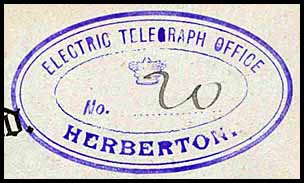 9 December 1889 (from the form). Provenance: Dave Elsmore. |
BO6 - ETO - 2.
|
 |
|
The township of Laura did not really develop until, after the discovery of gold in the broad district around the town of Palmer about 1873. It became a place where travellers coming from Cooktown could cross the Laura river on the way to the diggings. The telegraph office was opened at Laura in June 1876. A Post Office opened at Laura on 8 October 1888 but closed in February 1903. It reopened in March 1905. Early newspaper reports about 1876 refer to Blacksoil (Station) being 96 miles from Cooktown at the Laura River. Fairview (Station) is now about in the same locality. Laura is now famed for its magnificent collection of Quinkan Aboriginal rock galleries. The art has been dated to being 15,000 to 30,000 years old. |
|
|
Maytown (previously referred to as Edwardstown after the local butcher) was the main township on the Palmer River goldfields. It was very active from about 1873 to the 1920s. In 1875, Maytown became the administrative and business centre of the goldfields. Today only a few relics remain - including (thankfully) a few telegraph poles. A Post Office operated from 1876 to 1945 and the telegraph office was opened at Maytown in June 1876. In February 1885, tenders were called for a new Telegraph Office building. The problem was finding a suitable site. "A full meeting of the subscribers of the School of Arts unanimously surrendered the site required by the Telegraph Department for the new offices. This was only done when the general public took the matter up, fearing the Government would abandon the idea of erecting new premises. Thanks to the energy of several of our prominent townsmen, we hope shortly to see offices erected suitable to the climate and meeting the convenience of the public as well as the comfort of official occupiers" (The Queenslander 25 April 1885). Teamwork makes the Dreamwork!! In the Estimates laid in the House in September 1888, was an item for a Post and Telegraph Office at Adavale for £625. The Telegraph Office closed 2 October 1899. |
|
|
A telegraph Office was opened in McDonnell using the same prefabricated design as was used for the Musgrave Telegraph Office. A Post Office was open from 1912 to 1929 when telegraph facilities ceased. |
|
|
A telegraph Office was opened in Mein using the same prefabricated design as was used for the Musgrave Telegraph Office. A Receiving Office opened in February 1896. This was upgraded to a Post Office in 1 July 1929 but closed in April 1929 when telegraph facilities ceased. |
|
|
In 1887, a Telegraph Office was opened at Moreton using the same prefabricated design as was used for the Musgrave Telegraph Office. It is very close to the town of Dixie.
In 1896, a Receiving Office was opened at the Telegraph Office and that operation was upgraded to a Post Office in 1927. The Post Office was closed in 1977. |
|
The Telegraph Office was issued with an oval ELECTRIC TELEGRAPH OFFICE date stamp at some time. It was type BO6-ETO - 3A.
|
 Detail of the ETO oval date stamp on the cover below. |
|
|
| Musgrave.
The Telegraph Office was built in 1887 as part of Queensland's Overland Telegraph line. It was a repeater station with large banks of batteries and a generator to boost the power in the telegraph line. The telegraph station building was a high-set timber framed corrugated iron building, designed by the Colonial Architect and pre-cut in Brisbane. Using the same design, the Telegraph Department built telegraph stations at Fairview, Coen, Mein, Moreton, McDonnell and Paterson. |
||
|
||
From 1896 to 1927, the Office was a Receiving Office after which it became a Post Office until 1930. For further details, see elsewhere. The telegraph facilities ceased in 1929. The Telegraph of 7 July 1889 carried the note that "News has been received by the Cooktown police from the telegraph master at Musgrave that the blacks have cut the wires 20 miles from his station. They have secured a fine lot of wire to point their spears with and there will be more trouble in the Cape York Peninsula yet". Musgrave is the only overland telegraph station on Cape York that remains. The old wire has been replaced with modern microwave radio systems and optic fiber. Yarraden is nearby. |
||
| The Office was issued with an oval Electric Telegraph Office (type 3) brass date stamp (BO3-ETO).
|
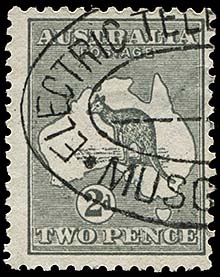 No date. Used on 2d grey Kangaroo on Map. Second watermark. Issued January 1915. |
|
 No date. Used on 1½d black-brown King George V.Second watermark. Issued from January 1919. |
 No date. Used on 1½d red-brown King George V. Second watermark. Issued from January 1922. |
|
|
The telegraph office was opened at Palmerville in June 1876. In October 1876, tenders were called for the construction of a Telegraph Office there. |
|
| Port Douglas.
The Telegraph Office opened on 23 May 1879. The Office was issued with an Electric Telegraph Office oval date stamp. |
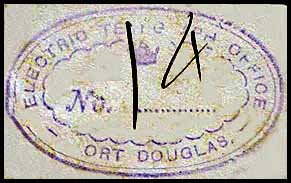 Port Douglas Electric Telegraph Office. P of PORT is missing. Oval Type 2A: BO7-ETO. No date. Size: 27 × 44 mm (e = 0.79). Provenance: Dave Elsmore. |
|
|
|
|
Located about 10 kms south-west of Innisfail, South Johnstone was originally called Basilisk. In 1954, the town was officially renamed South Johnstone. Nevertheless, the State School and the Post (& Telegraph) Office had been called South Johnstone at least by 1916.. |
|
| A postal date stamp for South Johnstone. |  26 May 1932. |
|
The telegraph office was opened at Tate in June 1876. It was renamed Tate Tin Mines Receiving Office in 1881. This office was upgraded to a Post Office on 1 December 1893 and closed on 9 September 1961.. |
|
|
The Telegraph Office opened on 26 August 1887. |
|
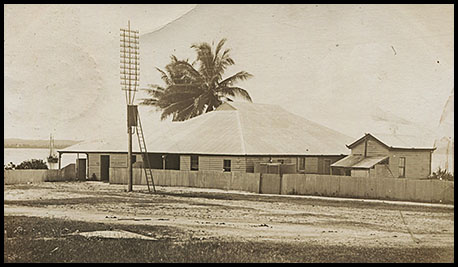 The Thursday Island Post & Telegraph Office. Postcard sent to Mosman (Sydney) with a "With love from Dad" message to his daughter from a Sailor aboard the S.S. Embling cargo ship. Has a Queen Victoria 1d orange tied by a Thursday Island postal date stamp of 18 May 1908. |
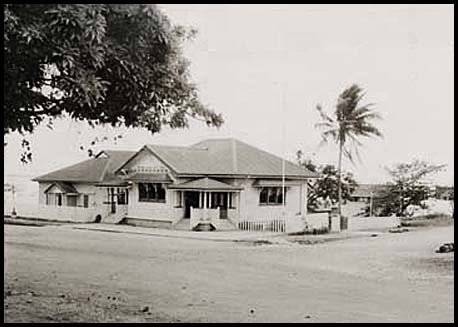 Thursday Island Post & Telegraph Office. Staff quarters are the building on the left. |
|
|
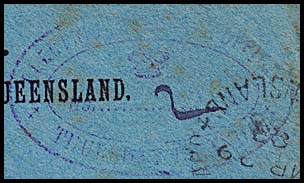 Thursday Island Electric Telegraph Office. Oval type 2A: BO3 - ETO. Detail of the oval date stamp on the delivery envelope. Size: 26 × 44 mm (e = 0.81). |
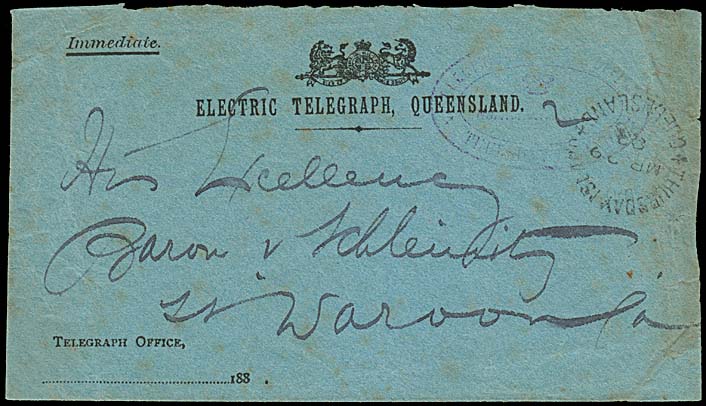 Delivery envelope (QC-EO-2). Thursday Island to Waroonga |
|
The telegraph office was opened at Walsh River in June 1876. The Brisbane Courier of 1 November 1893 reported that a prospector was travelling through the Walsh River country side: "Passing the Walsh telegraph office, I saw the operator in charge feeding the parrots and I never saw such a sight in my life. They were around him, on his head and shoulders, in hundreds and hundreds. He told me it was starvation which made them do this". It was still a polling place for electors at least in 1909. |
|

